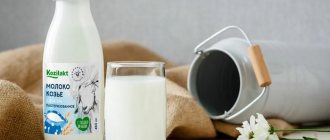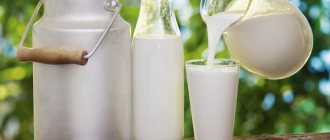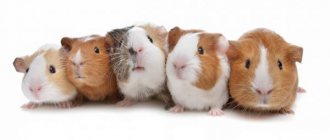According to the International Dairy Federation (IDF), as of 2022, the world produces about 850 million tons of milk per year, with the share of cow's milk being about 700 million tons. But in second place is goat milk, its share is about 15 million tons.
Now the Internet is full of articles about goat milk. About its study, properties, composition and undoubted benefits. But the information is very contradictory and not always reliable. Let's try to bring all the numerous data together, try to separate truth from fiction and find out whether goat's milk is as healthy as they say about it. And for clarity, let’s compare it with the most popular and affordable milk - cow's milk.
Let’s not go deep into the weeds and throw in complex chemical terms like lactoferrins and triglycerides, but let’s take the simplest criteria:
- Vitamins
- Fat content
- Squirrels
- Hypoallergenic
- Minerals
- Digestibility
- Smell and taste
- 8 Cost and availability.
So, let's begin!
Vitamins
Goat milk contains more:
- vitamin B6, responsible for the nervous and immune systems and tissue regeneration by 25%
- Vitamin A, also known as retinol, is necessary for good vision and immunity by 47%.
But cow's milk contains:
- 5 times more vitamin B12, its deficiency in the body leads to the development of chronic fatigue, anemia and schizophrenia.
- 10 times more B9 or folic acid, the absence of which can cause anemia, atherosclerosis, stroke and heart attack, and nervous disorders.
Vitamins C, E, N and D are approximately the same amount.
We will assume that there is a tie in this category and will award 1 point.
Features of goat product
Goat milk is one of the most valuable types of dairy products. It contains all the microelements necessary for the human body, and it also contains a lot of protein. The product is widely used for medicinal purposes. Easy digestibility makes it suitable for both children and adults.
This drink has a specific smell and taste. The calorie content of this nutrient liquid is 68 calories per 100 grams. The components of these products of animal origin: proteins (3%), fats (4.2%), carbohydrates (4.5%).
The drink includes a large number of vital elements: retinol, phosphorus, molybdenum, calcium, thiamine, pyridoxine, ascorbic acid, folic acid, pantothenic acid, vitamins B, C, D and H. It is also rich in antioxidants, iron, copper. The intensity of macro- and microelements is achieved through the nuances of goat nutrition. These cattle are selective about food - goats do not eat dirty, fallen leaves, they prefer only clean, healthy grass, fruits and vegetables.
Fat content
This figure is approximately the same - on average it is about 3 - 4%. But there is one difference, which is the structure of the fats. The fact is that milk fat is present in milk in the form of balls. (Yes, this is the most scientific term! One type of milk study involves counting the number and determining the shape of fat globules) So, these same fat globules in goat’s milk are much smaller than in cow’s milk and are evenly distributed throughout the entire volume milk rather than collecting on the surface. Which leads to better digestibility of goat milk.
Here we boldly give 1 point each, plus goat milk a point for digestibility.
The overall score is 3-2 in favor of goat milk.
Harm
Abuse of the product leads to unpleasant consequences, so you need to adhere to the rules and take into account contraindications.
- Complete replacement of mother's milk with goat's milk when feeding a baby can lead to iron deficiency anemia.
- Obesity, increased blood viscosity, gastrointestinal diseases are contraindications for use.
- It is not recommended to drink this drink before or immediately after meals, as this leads to a weakening of the proper functioning of the gastrointestinal tract.
Squirrels
The main protein in milk is the complex protein casein, which is responsible for the formation of curd. Thus, one of its four fractions, s1-casein, which is considered a strong allergen, is absent in goat milk.
The second component of milk protein is the simple whey protein albumin. In goat's milk it is represented by a fraction - lactalbumin, and in cow's milk - lactoglobulin. This leads to the fact that when curdled in the stomach, goat milk forms a softer, smaller clot and small, loose flakes, which makes digestion easier.
And, although the structure and composition of proteins are very different, their percentage in both types of milk is approximately 3.5 - 4%, therefore - one point each. And goat milk gets another point in the digestibility category.
5-3!
Amount of lactose
In the composition of this milk this figure is 10%. Compared to a cow product, this is not much. But if you have lactose intolerance, doctors still do not recommend its use. As a last resort, you can use it not in its whole form, but as kefir, cottage cheese, cheese, yogurt.
Hypoallergenic
Goat's milk is considered hypoallergenic. But that's not true. Many people cannot tolerate cow's milk, or rather its protein. Allergic reactions are expressed in skin rashes, digestive and even breathing problems. Goat milk also contains protein, yes, different, but still protein, to which you can also develop an allergy.
So here - one type of milk does not get a point.
Organoleptic properties
Simply put, the taste, smell, color of milk. There is an opinion that goat milk has, so to speak, a specific smell. But farmers have always known that this only happens in one case - if the dairy goat is kept in poor conditions. It is foolish to expect a quality product from an unkempt animal! Many experiments have been conducted to explore this area by asking people to blindly compare goat's milk with cow's milk. So, the majority of respondents preferred goat, saying that it was sweeter and more attractive in appearance, although an unusual smell was still noted.
So it's still a draw - one point each. Total, 7-4.
It should be noted that the Anglo-Nubian goats kept on our farm “Land of Friends” produce excellent milk, which initially does not have a specific smell, but has a creamy taste with notes of nut and nutmeg (this is such a feature of this breed of goats).
Minerals
The chemical composition of milk is incredibly complex. But we are only interested in the most important chemical elements for humans, presented in milk in the form of compounds.
The mineral content in both types of milk is again close - approximately 0.7-0.9%. But at the same time, goat milk contains much more:
- calcium and phosphorus, responsible for the condition of bones, teeth, hair
- potassium, which ensures efficient functioning of the cardiovascular system
- selenium, which is a powerful antioxidant.
At this point, 1 point for goat milk.
The overall score is 6-3 in favor of the goats.
New technologies
Traditional processing methods have disadvantages, due to which scientists are constantly looking for new technologies for the food industry. Today, new milk processing options are offered:
- Ultraviolet. The raw materials are treated with ultraviolet radiation, creating a sealed milk layer controlled in thickness. Irradiation is carried out in the range of 165-185 nm. Layer thickness – 80-120 microns. The technology uses the ability of ultraviolet radiation to destroy the DNA of microorganisms - they lose the ability to reproduce. The industry today produces light sterilizers SSM, which can be used in livestock farms.
Infrared. The industry produces devices - infrared pasteurizers, which are used to pasteurize the milk of cows with mastitis. This milk is not suitable for humans, but can be used to feed calves. There are 3 groups of devices - up to 300, 500-1500 and 2000-5000 l/h.
What is lactose intolerance?
The human body diagnosed with lactose deficiency does not fully absorb lactose , in other words, milk sugar.
After consuming products containing milk, people complain of upset stools and other stomach problems. Cells in the upper intestine secrete lactase. This is an enzyme that breaks down lactose. When the required amount of lactase is not available in the human body, some of the lactose ends up in the intestines. It absorbs lactase and produces special gases that create intestinal problems. Lactase also has a laxative effect. Symptoms of lactose deficiency appear about an hour after eating dairy products.
Everyone's reaction to lactose is different. Many patients drink a few cups of milk and have no problems with the tract. And some people do not tolerate small amounts of lactose well.
Types of Deficiency
- Primary . In children under seven years of age, the amount of lactase decreases slowly. Adults have a low level, but this is enough to consume dairy products. With this type of lactase deficiency, eating dairy products causes discomfort.
- Secondary develops at a time when lactase production becomes less after illness, surgery, etc. Having cured the cause of the disease, the amount of lactase in the body will be replenished over time.
- Congenital . This diagnosis is very rare. A person completely lacks lactase. This is a genetic disease. Lactose deficiency occurs in premature babies, since the maturation of cells responsible for lactase occurs in the third trimester. Then this enzyme returns to normal.
Fat content of goat's milk in percentage, how it differs from cow's milk, how much protein
Man has firmly fixed cow's milk in the diet, relegating goat's milk to the background. This is a real oversight as it is no less useful.
High fat content and more protein are the main differences between goat's milk and cow's milk. In addition, goat milk is rich in calcium. This is a product that will be a useful addition to your daily diet.
Goat milk fat content
Fats are what make this product so healthy. It is suitable for feeding people of all ages. fat in goat milk – 4.4%.
High fat content and more protein are the main differences between goat milk and cow milk
This is the optimal amount of nutrients for comfortable digestion of a milk drink. The small size of fat molecules - they are 2 times larger in cow's milk - contributes to the complete absorption of all components.
The amount of fat in a freshly milked product is constantly changing.
This occurs under the influence of a complex of factors:
- the interval from the beginning of lactation to harvest;
- compliance with housing and feeding standards;
- age of the goat;
- season of the year;
- breed of animal.
Milk productivity depends on two indicators: milk yield and fat content. The higher the second value, the lower the milk yield, and vice versa.
The numbers are easy to change to increase or decrease the adjusted indicator. This will require changes in diet or care.
Interesting! The composition of goat milk secretion directly depends on the breed.
Among the common varieties, the Nigerian dwarf (6.5%) and the Nubian goat (4.7%) have the highest fat content. The figure is lower for La Mancha (3.9%) and Oberhasli (3.6%). Saanen and Toggenburg breeds – 3.2%.
Which milk is fattier - cow's or goat's? Freshly milked products differ little. The average fat content of goat milk secretion is 3.9–8%, which is slightly higher than that of cows (3.5–5.2%).
Composition of goat milk and energy value
The composition of goat milk is constantly changing.
However, it was possible to establish the average energy value and content of the main elements (per 100 grams):
- protein – 3.2–3.6 g (12.8–14.4 kcal);
- fat content – 4.2–4.6 g (16.8–18.4 kcal);
- carbohydrates – 4.4–4.7 g (17.6–18.8 kcal);
- calorie content – 66–67 kcal.
Milk contains a complex of trace elements and minerals - copper, potassium, phosphorus, calcium, iron, manganese.
Vitamin composition: thiamine, riboflavin, cobalamin, ascorbic acid, retinol, vitamin D.
Goat milk contains many trace elements and minerals
Benefits of the components included:
- Vitamin A. Performs antioxidant functions, improves vision, hair, and skin.
- Carotene. The substance stimulates the immune system. A large amount of carotene gives the freshly milked secretion a pale yellow tint.
- Sialic acid. Activates the body's defenses, strengthens mucous membranes.
- Vitamin B12. The high content of cobalamin and cobalt has a positive effect on metabolic processes. Often goat product is prescribed to children with poor health.
- Albumins. The substances are easily digestible and accelerate the breakdown of proteins, turning them into flakes.
- Potassium. The mineral is involved in the formation and normal development of the heart and blood vessels.
- Magnesium. The substance is useful for normalizing protein synthesis, cellular growth and energy exchange.
- Manganese. The trace element participates in mineral metabolism and stimulates cellular respiration.
Separately note the amount of milk sugar. Lactose is a substance that is equally beneficial and harmful.
It has a beneficial effect on the nervous system, heart, blood vessels, normalizes calcium metabolism, but is often poorly absorbed. The amount of lactose in goat secretion is small, which makes it possible to include it in the diet of people with lactose intolerance.
100 g of goat milk contains from 3.2 to 3.6 g of protein, which is 5% of the daily value. For example: human breast milk contains 4 times less protein.
Medicinal properties - influence of fat content and composition
Goat product is beneficial for the human body. This is due to the complete composition and easy digestibility of the components. Regular inclusion of the drink in the diet strengthens the immune system.
Other medicinal properties:
- normalization of metabolic processes;
- stabilization of cholesterol levels in the blood;
- bactericidal;
- removal of waste, toxins, heavy metal salts;
- restoration of hormonal levels.
Drinking goat milk is allowed for patients with gastrointestinal diseases. The drink normalizes the digestive process and relieves unpleasant symptoms.
Goats provide a secret that is used to create food for children . Their stomach and intestines need easily digestible food.
How to determine the fat content of goat milk at home?
Shades of fresh milk depend on the degree of fat content
Determining the fat content of goat milk in percentage is possible only in the laboratory. However, there is a method applicable for home use. To do this you will need a smooth glass, a marker, and a ruler.
Procedure:
- Wipe the surface of the glass with a cotton swab dipped in alcohol.
- Measure 10 cm from the bottom and make a mark.
- Apply strips 1 mm wide - from top to bottom to the 9 cm mark.
- Pour 100 ml of goat drink, wait 10–12 hours. During this time the cream will rise.
- Evaluate the result - the distance from the top surface to the border of milk and cream in millimeters will indicate the fat content.
Determining the indicator will be needed if the product is purchased secondhand. In store-bought milk it is indicated on the label, but the meaning is not always accurate. Just for fun, you can use the presented method.
During pregnancy and lactation
A woman's resources are depleted when she is carrying a fetus or nursing a child. The baby absorbs the most beneficial properties from breast milk, but this same reserve must be replenished. The necessary calcium, fluorine, and other macro- and microelements are found in this drink. Also, due to some components, metabolism is facilitated, which is very important for the comfort of a nursing mother.
The requirement during pregnancy is 1-2 glasses. During lactation, to prevent allergic reactions, excessive consumption of such products is prohibited. To prevent the absorption of components in the baby, they begin to introduce the product gradually (from 1 glass per day).
Recommendations for use
A family usually buys about two or three liters of goat milk at a time. To make it beneficial, keep an eye on some points:
- Buy chilled.
- Ask how the owner cools it after milking the animal (need immediately after receiving milk).
- If you brought the jar home, put it in the refrigerator. Darkness and coolness are two conditions for maintaining quality.
- You need to drink it warm. Cold food inhibits enzymatic processing, and hot food is absorbed too quickly without interacting with stomach secretions.
- Milk should be heated in a water bath, not over an open fire.
- It is better for health if the intake of the drink is alternated with the use of fermented milk drinks (yogurt, bifida, kefir).
- The last dose is 2-4 hours before bedtime, but no later than nineteen hours.
- Not all medications can be taken with it. Usually at the appointment the doctor advises the patient on this matter. But it’s better to play it safe and ask an additional question.
- The product brings benefits to the body, but not with a single use, but in cycles of at least ninety days.
- Ideally, it should be drunk without combining it with other types of food. In the morning before breakfast at least an hour. In the afternoon, an hour and a half before lunch. In the afternoon, without eating sandwiches and flour products. The doctor will give you specific recommendations for mixing it with juices and herbal infusions.
Fulfill all the conditions - and goat’s milk will become a real natural healer.
Why can't you drink it with bread, meat or vegetables?
Milk does not like combinations with other products and can cause flatulence or loose stools. Even with a good habit of it and the absence of unpleasant consequences in such cases, it does not turn into a medicine, into a nutritious product, nothing more.
Why should farmers refrigerate it immediately after milking a goat?
Fresh milk has the ability to kill pathogenic bacteria; it contains special bactericides for this purpose. It is a good immunostimulant and has an anti-inflammatory and anti-disbacteriosis effect.
120 minutes is the time when harmful organisms in a freshly milked drink do not divide: the bactericidal stage. It is prolonged by cooling. Beneficial compounds will last forty-eight hours if properly stored and initially refrigerated. If you do not follow the technology, then within six hours the unique healing properties will disappear.
Some vitamins and enzyme complexes are destroyed in light. Hence the rule of storage in a dark place. The tighter the lid is closed and the cleaner the filling container, the longer the product will not become contaminated with harmful microorganisms. But if you close a steamed drink, it will “suffocate.”
Do not use containers made of aluminum, plastic or galvanized for carrying and storage.
Features of cow drink
It is produced by farmers in large quantities. This is the most sold type of milk.
The milk of some cow breeds can be as fatty as goat's milk. The product contains more than 50 valuable components. These include all vitamins B, E, A, D, H, choline, nucleic acids, monounsaturated fatty acids, beta-carotene, essential amino acids, potassium, phosphorus, micro- and macroelements. The amount of calcium is from 100 to 150 mg.
It is impossible to say with certainty that the product is hypoallergenic. However, goat milk can also cause an adverse reaction.
Fat content of goat and cow milk and how to determine it at home
Dairy products play an important role in human life, and especially children. By comparing the fat content of goat and cow milk, as well as other indicators, you can decide which one is healthier. Experts talk about the content of vitamins, microelements and other useful substances in the product. But the fat content of milk can be determined even at home.
What is the fat content of goat's milk?
The fat content of goat's milk varies from 3.2% to 6.5%. This percentage depends on several reasons. First of all, the composition of the final product is influenced by the breed of the animal. The highest fat milk comes from Nigerian Dwarf goats. The Saanen and Toggenburg have the lowest fat content.
The amount of fat in a dairy product is influenced by the feed used. In the spring, when goats eat young growth, milk yield increases, but the fat content of the milk decreases. During this period, concentrated feed should be added to the diet. From mid to late summer, when the grass loses its juiciness, the nutritional value of milk increases, but its quantity decreases.
To increase milk yield, animals are fed succulent foods. These can be various vegetables and fruits, such as pumpkin, zucchini, apples. It is advisable to give a mixture of these fruits.
The fat content of goat milk changes to a large extent during lactation, which lasts about ten months. After the birth of a kid, the goat produces colostrum of high oil content for up to fifteen days.
Then, about nine months, the milk yield is of medium fat content. Milk production ends with the fifteen-day release of high-fat milk, which is called old milk.
After this, the goat must be inseminated so that it begins to produce milk again.
Among other things, the fat content and quantity of a dairy product is influenced by genetic factors, metabolic rate, and harmonious body structure. The ability to care for the udder depends on the owner.
It should be kept clean, properly milked and massaged, and milked at least three times a day. Morning milk always contains a higher percentage of fat content.
With good care and proper feeding, a goat, on average, produces three liters of milk.
When buying milk in a store, you can easily find out its fat content; such information is contained on the packaging.
Veterinary laboratories, production facilities and reception centers have special equipment that can accurately determine the composition of milk within a few minutes.
Owners of mini-farms can seek help from specialists to accurately determine the fat content of milk yield. It will be more difficult to determine the fat content in homemade milk or purchased from private owners on the market, but it is still possible. To do this you need:
- Prepare a glass, marker or felt-tip pen, ruler or tape measure.
- Wipe the top of the container with a cotton pad soaked in alcohol.
- Measure ten centimeters from the bottom of the glass, making markings one millimeter at a time.
- After the measuring cup is ready, one hundred milliliters of milk is poured into it.
- After twelve hours, you can evaluate the result. The thickness of the cream layer, measured in millimeters, will indicate the percentage of fat content.
This is the only way to determine the approximate fat content of milk at home.
Which milk is fattier: goat's or cow's?
If you compare goat and cow milk, the former is certainly fattier. To check this, you need to pour goat's milk into one glass, and cow's milk into the second.
After a few hours, cream appears on the surface of the milk, but settled cow's milk becomes bluish, and goat's milk does not separate all the fat, since it is fine-grained, fat globules are distributed throughout the entire volume of the glass.
Despite the fact that the cream layer is almost the same, the fat content of the milk differs significantly.
Depending on the breed of goat, fat content ranges from three and a half to six percent. And homemade cow's milk is from 3.2 to 5%.
All milk contains the same substances, but their quantities are different. Goat product contains more calcium (33%, cow product – 28%), higher calorie content, more iron, vitamin A, potassium, magnesium. The level of healthy fatty acids is 15% higher than in cow's milk.
Goat milk has a low lactose content and half the fat molecules, which allows the product to be better absorbed. There is no A1 casein, thanks to this feature the product does not cause allergic reactions. Saturated fats promote better absorption of vitamins.
Although goat's milk is fattier than cow's milk and may be considered harder on the body, this is not the case. Due to the presence of fat in a finely dispersed state, the product is well absorbed even by a child’s body. The presence of beneficial amino acids, vitamins and other substances has a beneficial effect on the gastrointestinal tract and other human organs.
Source: https://DachaMechty.ru/kozy/zhirnost-moloka.html











